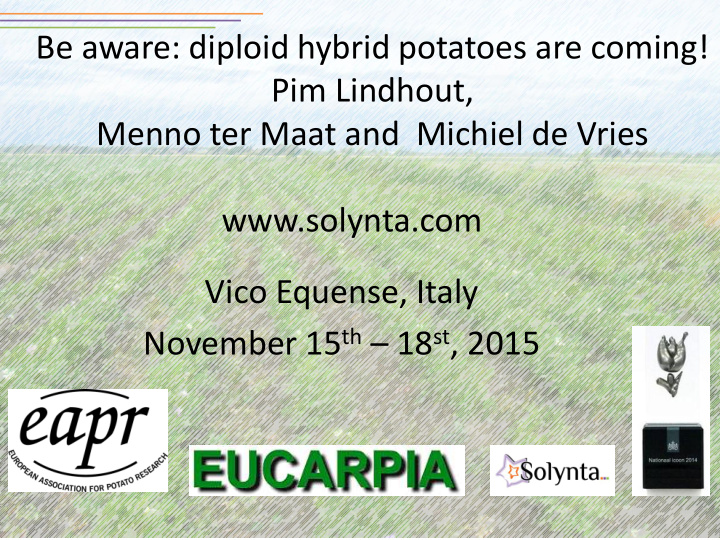



Be aware: diploid hybrid potatoes are coming! Pim Lindhout, Menno ter Maat and Michiel de Vries www.solynta.com Vico Equense, Italy November 15 th – 18 st , 2015
Theo Schotte, breeding Pim Lindhout, R&D Johan Trouw, Seed productio Hein Kruyt, business development Solynta staff in 2006 - 2011 EAPR meeting, OULU, Finland Food Valley 140313 2
Solynta staff in 2015
Hybrid breeding
Corn as example for F 1 hybrid breeding Potato today
Hybrid breeding has great advantages Traditional breeding Hybrid breeding 15 – 50 years 2 – 3 years Introduction one trait Impossible 3 – 7 years Trait stacking 4 years Phytophthora resistance > 50 years Vegetative > 5 y ½ year Multiplication contaminated clean Seed health Russet Burbank Dynamic introductions Conclusion (1876) of innovative products Value creation Disruptive change
400.000 plants = 10 ha commercial potato field ~ 200 gram seeds = envelope ~ 25 ton seed tubers = big sea container
The first draft potato genome sequence
The first draft potato genome sequence • Frequency of SNPs in DNA 1 per 80 bp comparing man and chimpanzee • Frequency of SNPs in DNA comparing the two genomes of the 1 per 28 bp heterozygous diploid RH So, potato has tremendous genetic variation
Conclusion: Potato is an extremely heterozygous crop, that harbours many deleterious alleles, which are the cause of inbreeding depression Proof of Principle: • Generate inbred lines • Make hybrid by crossing these inbreds
Homozygocity increase by selfing is much faster in diploids as compared to tetraploids
diploid germplasm Short description Abbr. H Sli locus donor+ fertility+ homozygosity D1 Y (yellow flesh), Qcook D2 Early, Y, Qcook D3 R3 , Nematode H1 , Gpa2 , virus RXadg , Y D4 Nematode Grp1 , early, long (shape) D5 Early, long, Y, Qfry D6 Long, Y, Qfry, H1 , Qcook D7 Early, long, Y, H1 , Qcook, Zep (orange flesh) D8 Early, y (white flesh) D9 Qstarch, Y D10 Wild species hybrid: late blight Rpi-avl (S. avilesi) D11 Wild species hybrid: late blight Rpi-rch (S. rechei) D12 Round (shape), Qcook, Qfry Early, round, Zep (orange flesh), Y, spectacled, Qcook, blue D13 anthocyans D14 Wild species hybrid: late blight Rpi-tar (S tarijense) D15 Early, late blight Rpi-vnt1 (S. venturii) , round, Y, H1 D16 Early, round, y (white flesh)
Donor Sli gene The donor material is weak: bad germination, slow emergence, weak seedling growth, late and poor flowering, fragile flowers, limited pollen production, lack of vigour, poor tuber shape and quality and low tuber yield. Proof of inbreeding depression or basis for developing good performing inbred clones?
Sli parent Elite clone F 3 progeny clones
2009: Proof of principle F 1 hybrid breeding
Hybrid breeding Requirements: Diploid germplasm Self-compatibility ( Sli -gene) Goal: homozygous self-compatible lines
Breeding started in 2010 EAPR meeting, OULU, Finland EAPR meeting, OULU, Finland EAPR meeting, OULU, Finland
Planting mechanisation
(Ex-)minister of Agriculture Sharon Dijksma supporting Solynta breeding in greenhouse
SNP markers in inbred development in diploid potato F 3 F 1 parents F 2
% homozygocity observed expected DS parent 98 D 2 parent 39 F 1 30 - 38 31 F 2 27 - 70 65 F 3 58 - 87 82 F 4 49 - 96 91 F 5 65 - 97 95 F 3 F 1 parents F 2
Recommend
More recommend